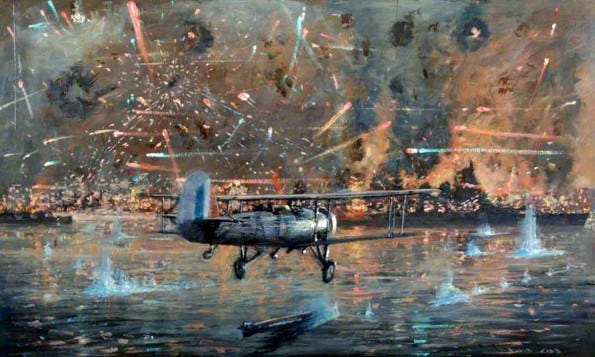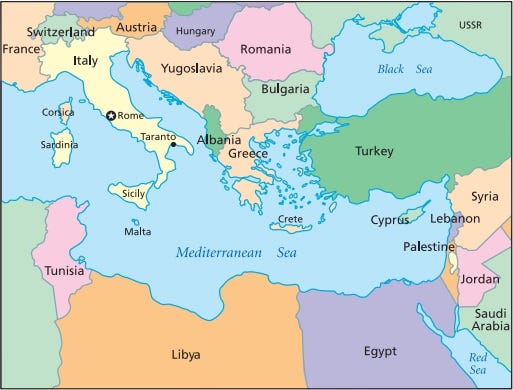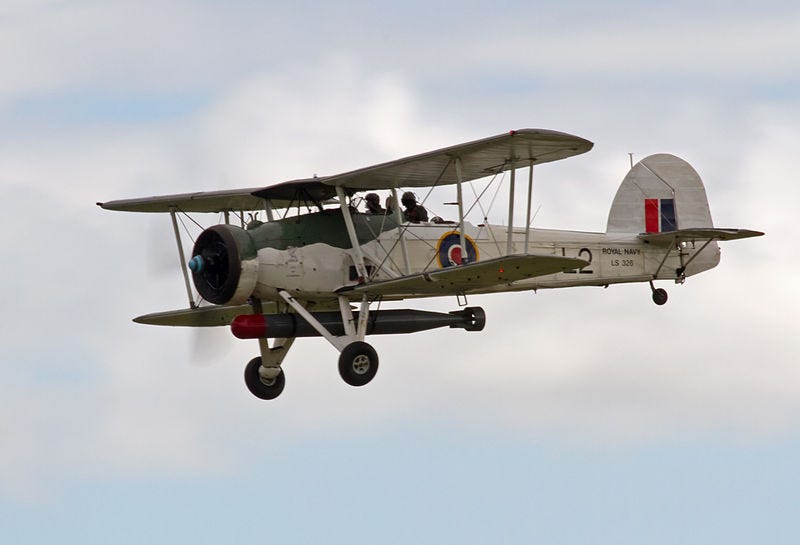The Unseen Influence: Taranto Raid and Its Legacy on Pearl Harbor
Written on
The Prelude to an Iconic Attack
When contemplating a carrier-based strike on naval forces at anchor during World War II, one often thinks of the infamous assault on Pearl Harbor. However, preceding this event was another notable carrier raid that could have shaped the strategies employed at Pearl Harbor. This raid unfolded on the opposite side of the globe and remains less recognized, particularly in the United States.
In the early days of WWII, Britain faced a significant challenge in the Mediterranean Sea, where a formidable Italian fleet posed a threat. Although not regarded as a dominant naval power, the Italians boasted six battleships and several cruisers that could create potential issues. This Italian fleet generally refrained from engaging with the British, instead opting for a strategy known as a “fleet in being.”
A fleet in being projects strength merely by existing in port. While it remains docked, it must be considered a threat; if it ventures out, it risks destruction.
The conflict had extended to North Africa, allowing the Italians to easily navigate the Mediterranean to their Libyan base and supply Axis forces. The British aimed to neutralize the Italian fleet to gain greater operational freedom in the Mediterranean and beyond. Without this fleet in being, British vessels could focus on disrupting supply lines to North Africa and operate freely in other regions, while British supplies to Egypt would become less vulnerable to possible Italian attacks.

The Italian Fleet’s Stronghold
The epicenter of the Italian fleet was located in the port of Taranto, where six battleships, nine cruisers, and eight destroyers were anchored, safeguarded by torpedo nets and barrage balloons. The harbor’s robust defenses made a direct naval assault implausible. Nevertheless, the British navy had access to several aircraft carriers and had conceptualized a carrier-based raid.
Operation Judgement: The Attack
The initial plan involved two aircraft carriers deploying 36 Fairey Swordfish bombers to strike the fleet. Although these biplanes were considered outdated, they were capable of launching torpedoes from a carrier. Their slow speed raised concerns about the attack's feasibility, especially against a harbor defended by 101 anti-aircraft guns and 193 machine guns.
To counteract the heavy defenses, the assault was scheduled for nighttime. Luckily, the Swordfish could operate in low light. They could also carry extra fuel tanks to extend their range, with some planes equipped with flares to illuminate targets.
Due to damage sustained by the British carrier Eagle, only one carrier, the Illustrious, was available for the mission, which had 21 Swordfish bombers on board, while others were grounded due to mechanical failures. Despite a reduced attacking force, the operation proceeded on the night of November 11, 1940.
The British had additional advantages, particularly with their torpedoes, which featured a duplex pistol trigger technology that the Italians were unaware of. This allowed the torpedoes to detonate upon proximity to a ship's hull, meaning they did not have to strike the target directly to explode.

The Italian barrage balloons, designed to deter aerial attacks with their steel cables, were also compromised. Originally, 90 balloons were deployed, but only 27 were operational during the raid.
The planes were launched in two waves: the first wave had twelve aircraft, and the second consisted of nine. Ten planes carried a combination of bombs and flares, while the other eleven were armed with torpedoes. The torpedo-equipped planes had to descend to 150 feet to effectively strike their targets. High casualty rates were anticipated due to the low-altitude approach against heavily armed warships.
In the aftermath, Italy’s operational battleships were reduced from six to three, with damage also inflicted on a cruiser and several destroyers. Remarkably, the British only lost two planes despite the intense anti-aircraft fire. A planned follow-up attack the next night was canceled due to inclement weather, but the British Admiralty deemed the operation a resounding success. While some historians dispute this, it is evident that the raid demonstrated the efficacy of carrier-based air attacks against formidable naval forces.

The Broader Implications of the Raid
This operation illustrated the capability of carrier-launched aircraft to effectively engage a robust naval fleet. The successful deployment of torpedoes in shallow harbor waters challenged Italian assumptions about naval warfare. This incident foreshadowed a significant shift in naval combat strategy, indicating that capital ships would gradually lose their dominance.
The raid also presaged a pivotal event one year later — the Japanese assault on Pearl Harbor.
Did the Taranto Raid Influence Japanese Strategy?
Was this attack a catalyst for the Japanese decision to strike Pearl Harbor? While certainty eludes us, it is known that the Japanese dispatched an officer to investigate the raid. Lieutenant Commander Takeshi Naito was sent from Berlin to Taranto to gather intelligence, and he later briefed Commander Mitsuo Fuchida, who led the Pearl Harbor attack. Additionally, other Japanese naval officers traveled to Taranto to consult with their Italian counterparts in May 1941.
It is not far-fetched to assume that the Japanese meticulously analyzed this raid and contemplated its implications. The damage inflicted by a single carrier with 21 outdated biplanes raised questions about what multiple carriers utilizing modern aircraft could achieve.
Even if plans for the Pearl Harbor attack were already underway, the Taranto Raid likely reinforced the notion of launching torpedo attacks against a fleet in a shallow harbor. The Japanese interest in Taranto certainly adds weight to this theory.
Thank you for engaging with this analysis. If you found this piece insightful, please consider sharing it.
This video provides a detailed overview of the Taranto Raid, often referred to as the "Italian Pearl Harbor." It examines the tactics used and the consequences of the attack on naval warfare.
This documentary explores the Taranto Raid of 1940, highlighting how this British attack inspired the planning of Japan's Pearl Harbor strike.